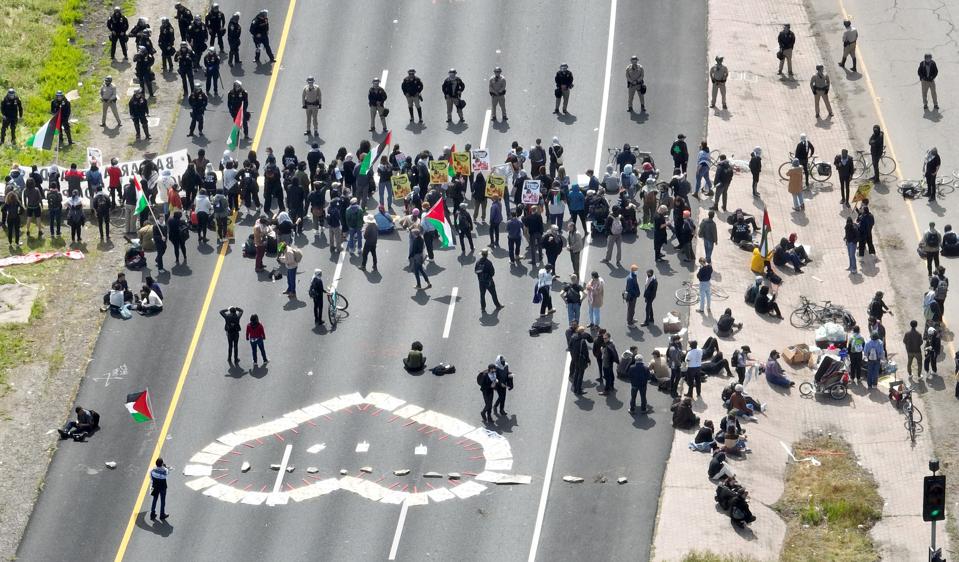For months, large-scale protests around the world have sought to bring attention to the Palestinian cause. Such was the case on Monday, as protestors shut down San Francisco’s Golden Gate Bridge, snarled traffic on the Brooklyn Bridge in New York City, and even blocked traffic to Chicago’s O’Hare International Airport.
“Peaceful protests—as we know—are protected by the First Amendment, and as such, anyone on any side of any issue is free to make their beliefs known within some fairly broad parameters,” explained Susan Campbell, distinguished lecturer of communications, film and media studies in the College of Arts & Sciences at the University of New Haven.
Though the protests did receive brief coverage on the evening news, photos and videos quickly went viral across social media—which has shown to be far more effective in spreading the news to the masses. This was notable too as so much mainstream media coverage was devoted to the criminal trial of former President Donald Trump in Manhattan, and the aftermath of Iran’s drone and missile strike on Israel over the weekend.
Social media gave a platform for a notable, but still less significant, event.
“As with every other act—private or public—social media allows news of such events to spread quickly,” said Campbell. “I’ve seen reports of protests in other countries that look pretty impressive, but they are rarely covered by the mainstream media in countries other than the site of those protests. When all eyes are on the Trump criminal trial in NYC, social media may be the most attention such protests get.”
It could even be argued that social media can amplify protest events more than ever before.
“These amplifications also reach audiences that are more likely to be receptive to them,” added Dr. Julianna Kirschner, lecturer at the Annenberg School for Communication and Journalism at the University of Southern California.
Winning Hearts And Minds
The protests were largely meant to remind the world of the humanitarian crisis in Gaza, but the effectiveness is still a matter of debate. What social media may allow, however, is for a cause to trend.
“People who were already predisposed to agree with the sentiments expressed by the protesters will become further influenced by such content on social media,” suggested Kirschner. “The evening news has to be selective in what they broadcast due to time constraints. Social media platforms do not have that issue, but they fare worse in terms of addressing issues when compared to the evening news. If the goal is to change minds or to persuade, social media platforms cannot do much to accomplish that, given their algorithmic design.”
Is It Backfiring?
Though it is clear that Monday’s protests quickly went viral across social media, it was also apparent from the comments that many didn’t support the cause. Some quickly responded that Israel’s actions were brought on by the horrific terrorist attack on October 7—while images of protestors burning American flags, and videos that captured protests of “Death to America” also could be seen to undermine the cause.
Even the fact that the protests made some miss flights, or struggle just to get to work likely didn’t exactly help matters either. This isn’t limited to the pro-Palestinian protests, as climate activists have used similar tactics to draw attention to environmental issues.
“Protests are staged to draw attention to a particular situation, and shutting down a main thoroughfare or a large airport will definitely draw attention to the cause,” suggested Campbell.
“Of course, when attention is drawn by interrupting someone’s ability to move about freely, the attention won’t always be positive,” she continued. “We’ve seen this on a smaller scale all over the country with local protests. You go where you can get attention such as airports or highways or entrances to heavy traffic areas. Protesters block a highway and that can anger people who actually support the cause.”
Protest organizers likely weighed such decisions, and from the responses, it seems the likelihood of users changing their collective minds in such a politically charged environment appears low.
“Content that does go viral tends to be divisive already,” said Kirschner. “These protests will be exposed to more criticism online as they become viral because more than just sympathetic eyes are on them. More exposure means more criticism.”
Little Debate
Yet, it is worth remembering too that social media platforms do not create an environment for true debate with rules and expectations.
“Social media content tends to be a free-for-all, wherein users make the most outrageous claims in order to get more views, likes, and shares,” noted Kirschner. “At best, online responses are a distraction from the real issues, and any movement can stagnate in that setting. At worst, this environment can hurt any cause that seeks to advance and progress. The goal is no longer an exchange of ideas and perspectives. It has become a quest for popularity.”

